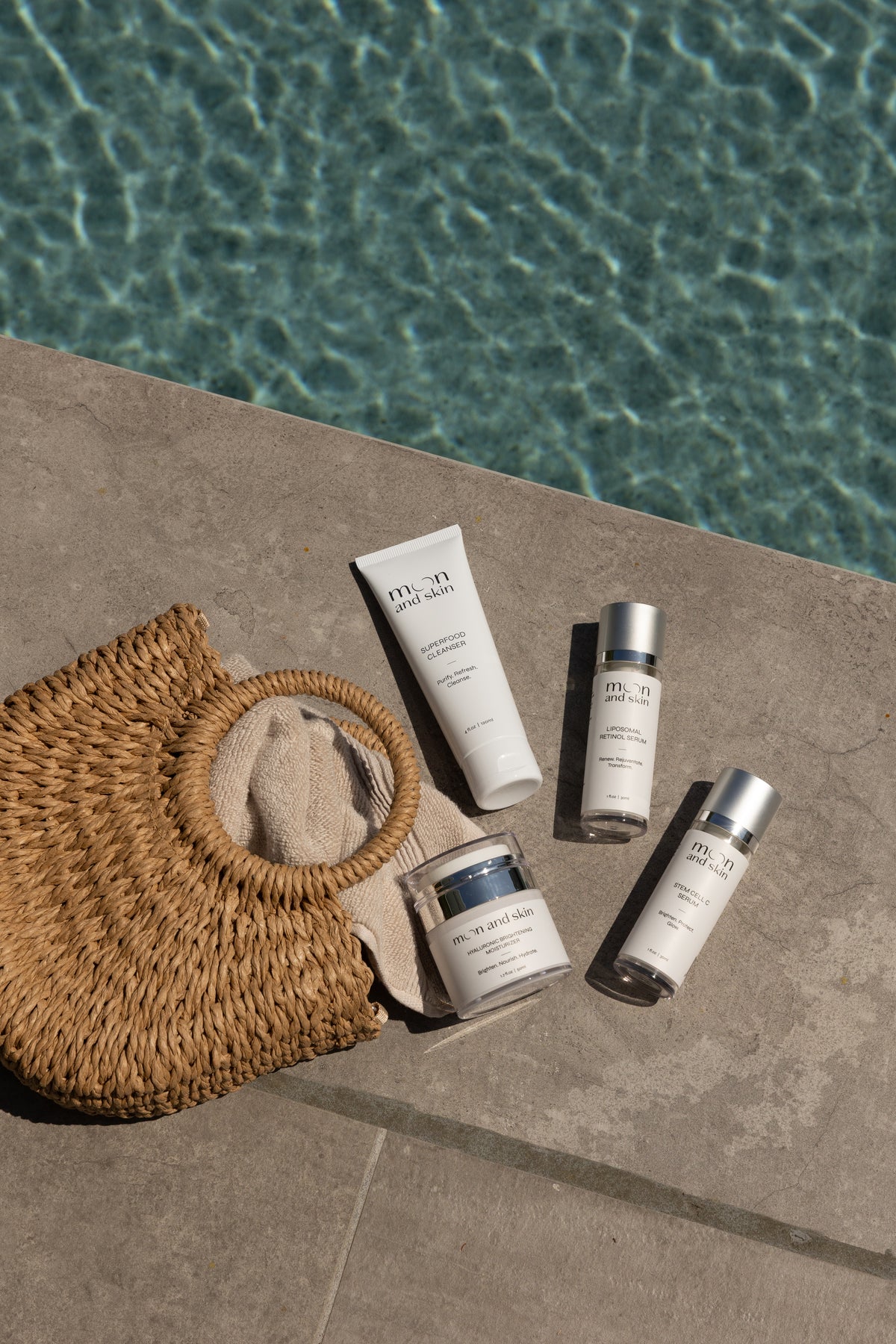Table of Contents
Introduction
Have you ever found yourself in a skincare aisle, overwhelmed by the sheer number of serums and treatments, wondering which ones are truly essential? If you’re looking to elevate your skincare routine, two ingredients stand out: retinol and vitamin C. These powerhouse components are renowned for their transformative effects on the skin, making them staples in many people’s beauty arsenals.
As we navigate the complexities of skincare, understanding when to use retinol and vitamin C is pivotal. You might be surprised to learn that while both ingredients boast incredible benefits for your skin, they function best when applied at different times of day. This is due to their unique properties and the way they interact with the skin.
In this blog post, we will explore the individual benefits of retinol and vitamin C, how to incorporate them effectively into your skincare routine, and why we believe that both can coexist beautifully in your regimen. Together, we'll uncover the science behind these ingredients and provide actionable insights to help you achieve healthy, radiant skin.
Let's dive in!
Understanding Retinol and Its Benefits
What is Retinol?
Retinol is a derivative of vitamin A and is widely celebrated for its ability to promote skin renewal. It works by accelerating cell turnover, which helps to shed dead skin cells and encourage the growth of new ones. This process can significantly improve skin texture, reduce the appearance of fine lines, and even help with issues like acne and uneven skin tone.
Key Benefits of Retinol
- Promotes Cell Turnover: Retinol encourages the shedding of old skin cells and the production of new ones. This leads to smoother, brighter skin over time.
- Reduces Signs of Aging: By stimulating collagen production, retinol can help diminish the appearance of fine lines and wrinkles, giving your skin a more youthful appearance.
- Improves Skin Texture: Regular use of retinol can enhance skin texture, making it feel softer and look more refined.
- Addresses Acne: Retinol's ability to prevent clogged pores makes it an effective treatment for acne. It can also help reduce the visibility of acne scars by promoting healing.
- Enhances Skin Radiance: With continued use, your skin can achieve a natural glow as dead cells are sloughed away and fresh, healthy cells rise to the surface.
How to Use Retinol
When incorporating retinol into your routine, we recommend starting slowly. Begin with a low concentration and apply it once or twice a week, gradually increasing frequency as your skin builds tolerance.
At Moon and Skin, our Liposomal Retinol Serum is designed with a unique delivery system that maximizes results while minimizing irritation, making it an excellent choice for both retinol novices and veterans alike.
Understanding Vitamin C and Its Benefits
What is Vitamin C?
Vitamin C, also known as ascorbic acid, is a potent antioxidant that plays a crucial role in skin health. It helps to protect the skin from environmental stressors, such as pollution and UV rays, while also promoting collagen formation for a more youthful complexion.
Key Benefits of Vitamin C
- Boosts Collagen Production: Vitamin C is essential for the synthesis of collagen, the protein that keeps skin firm and elastic. With increased collagen levels, your skin can appear more youthful and plump.
- Fights Free Radicals: As an antioxidant, vitamin C neutralizes free radicals, helping to prevent oxidative stress that can lead to premature aging and skin damage.
- Brightens Skin Tone: Vitamin C can help even out skin tone by inhibiting melanin production, making it effective for reducing dark spots and hyperpigmentation.
- Enhances Sunscreen Efficacy: When used alongside sunscreen, vitamin C can enhance your skin's defense against UV rays, providing an extra layer of protection.
- Reduces Inflammation: Vitamin C has anti-inflammatory properties that can help soothe irritated skin and reduce redness.
How to Use Vitamin C
To reap the full benefits of vitamin C, we recommend using it in the morning. Apply it to clean, dry skin before your moisturizer and sunscreen. Our Stem Cell C Serum is formulated with advanced plant-cell technology to deliver powerful antioxidant benefits while brightening and protecting your skin throughout the day.
When to Use Retinol and Vitamin C
Timing Matters
The key to effectively using retinol and vitamin C lies in understanding their distinct properties and how they function best.
- Morning Routine: Start your day with vitamin C. Applying a vitamin C serum in the morning prepares your skin to combat free radicals and environmental stressors throughout the day. This is crucial for maintaining a radiant complexion.
- Evening Routine: Reserve retinol for your evening routine. Since retinol can increase sun sensitivity, nighttime application allows it to work its magic while your skin repairs and regenerates overnight.
Layering Techniques
To maximize the benefits of both ingredients, consider the following layering techniques:
- Vitamin C First: In the morning, cleanse your skin, apply your vitamin C serum, and follow up with a moisturizer and sunscreen.
- Retinol Application: In the evening, cleanse your skin again, apply your retinol serum, and finish with a rich moisturizer to lock in hydration.
By using these ingredients at different times of day, you can minimize irritation while still enjoying their powerful benefits.
Potential Side Effects and Considerations
Skin Sensitivity
Both retinol and vitamin C can cause skin irritation, especially when first introduced into your routine. It’s essential to listen to your skin and adjust usage accordingly. If you experience redness or peeling, consider reducing the frequency of application or consulting with a skincare professional.
Patch Testing
Before fully integrating new products into your routine, we recommend performing a patch test. Apply a small amount of the product to a discreet area of skin and observe for any adverse reactions over 24 hours.
Combining with Other Ingredients
When using retinol and vitamin C, be cautious about combining them with other active ingredients. For example, avoid using strong exfoliants or acids on the same days as these potent actives to prevent over-exfoliation and irritation.
Summary of Key Takeaways
- Retinol and Vitamin C: Both are powerful skincare ingredients that can significantly improve skin health and appearance when used correctly.
- Timing: Use vitamin C in the morning and retinol in the evening to maximize benefits and minimize irritation.
- Layering: Apply vitamin C serum first in the morning and retinol serum in the evening, following up with appropriate moisturizers.
- Skin Sensitivity: Monitor your skin's reaction and adjust usage as necessary, performing patch tests when trying new products.
Conclusion
Incorporating both retinol and vitamin C into your skincare routine is a proactive step toward achieving healthier, more radiant skin. By understanding when to use each ingredient, you can unlock their full potential, addressing a variety of skin concerns from aging to pigmentation.
We invite you to explore our Bundle & Save collection, which features our core products, including the Liposomal Retinol Serum and the Stem Cell C Serum. Together, these products can provide a powerful foundation for your skincare routine, supporting your skin through every phase of life.
FAQs
Can I use retinol and vitamin C together at the same time?
While you cannot layer them directly due to their different pH requirements, you can use them in the same routine as long as they are applied at different times of the day.
How often should I use retinol?
Start with retinol once or twice a week, gradually increasing frequency as your skin builds tolerance.
What should I do if my skin becomes irritated?
If you experience redness or irritation, reduce the frequency of application. Ensure you are following up with a good moisturizer to keep your skin hydrated.
Should I use retinol every night?
Once your skin becomes accustomed to retinol, you can use it every night. However, if you are new to retinol, it's best to start slowly.
Can I use vitamin C at night?
Yes, vitamin C can be used at night, but it is most beneficial in the morning to protect against environmental stressors throughout the day.
By following these guidelines and incorporating our thoughtfully formulated products, you can achieve your skincare goals while celebrating your skin's unique journey.







